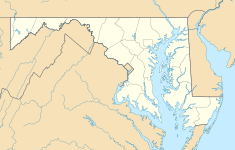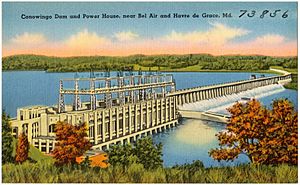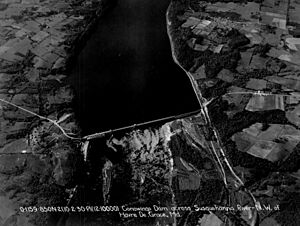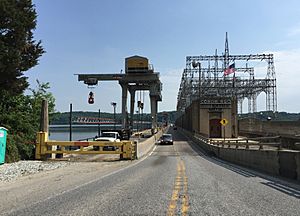Conowingo Dam facts for kids
Quick facts for kids Conowingo Dam |
|
|---|---|
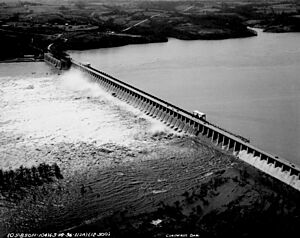
Conowingo Dam, aerial view (1936)
|
|
|
Location of Conowingo Dam in Maryland
|
|
| Official name | Conowingo Hydroelectric Station |
| Country | United States |
| Location | Cecil and Harford counties, Maryland |
| Coordinates | 39°39′36″N 76°10′26″W / 39.66000°N 76.17389°W |
| Status | Operational |
| Construction began | 1926 (completed in 1928) |
| Opening date | 1928 |
| Owner(s) | Susquehanna Electric Company |
| Dam and spillways | |
| Type of dam | Gravity dam |
| Impounds | Susquehanna River |
| Height | 94 ft (29 m) |
| Length | 4,648 ft (1,417 m) |
| Reservoir | |
| Creates | Conowingo Reservoir |
| Total capacity | 310,000 acre⋅ft (0.38 km3) |
| Active capacity | 71,000 acre⋅ft (0.088 km3) |
| Surface area | 9,000 acres (3,600 ha) |
| Maximum length | 14 mi (23 km) |
| Maximum water depth | 105 ft (32 m) |
| Normal elevation | 109.2 ft (33.3 m) |
| Power station | |
| Operator(s) | Constellation Energy |
| Commission date | 1928 |
| Type | Run-of-the-river |
| Turbines | 7 x 36 MWe, 4 x 65 MWe |
| Installed capacity | 548 MWe |
| Website Conowingo Hydroelectric Generating Station |
|
The Conowingo Dam is a massive hydroelectric dam located on the lower Susquehanna River in Maryland. It's one of the largest non-government dams in the United States. In fact, it's the biggest dam in the entire state of Maryland!
This important dam is about 10 miles (16 km) from where the Susquehanna River meets the Chesapeake Bay. It sits right on the border between Cecil and Harford counties.
The dam creates a huge body of water called the Conowingo Reservoir, which covers about 9,000 acres. This reservoir actually flooded the original town of Conowingo. So, the town had to be moved to a new spot about 1 mile (1.6 km) away. The old Conowingo Bridge was also taken down, and now U.S. Route 1 crosses right over the top of the dam.
The Conowingo Reservoir and the nearby Susquehanna State Park are popular places for outdoor activities like boating and fishing.
Contents
Building the Conowingo Dam
The area where the dam stands was once known as Smyth's Falls, even appearing on a map from 1612 by John Smith.
The Philadelphia Electric Company decided to build the dam. They hired Stone & Webster to design it and the Arundel Corporation of Maryland to build it. Construction began in 1926 and finished quickly in 1928. When it was completed, it was the second-largest hydroelectric project in the U.S. for making electricity, after Niagara Falls.
Life During Construction
About 5,000 workers came to this part of Maryland to help build the dam. They worked hard, moving railroad tracks, paving new roads, and setting up huge towers for power lines. Building such a large structure was very difficult. Many workers faced dangerous conditions, and sadly, some lost their lives during the construction.
How the Dam Makes Electricity
The Conowingo Dam is a hydroelectric power plant. This means it uses the power of moving water to create electricity.
Turbines and Generators
The dam was built with 11 spots for machines called turbines, but only 7 were put in at first. These turbines spin generators that produce 36 megawatts of electricity each. In 1978, four more powerful turbines were added. Each of these new turbines can generate 65 megawatts. This increased the dam's total power output from 252 to 548 megawatts.
The electricity is first made at 13,800 volts. Then, it's boosted to 220,000 volts to travel long distances, mostly to the Philadelphia area. In 2021, the dam produced 2.1 million megawatt-hours of electricity.
Today, the dam is operated by the Susquehanna Electric Company, which is part of Constellation Energy. The Conowingo Hydroelectric Station is so important that it could even restart the entire regional power grid if there was a huge blackout.
Controlling Floods with the Dam
The dam has 53 large flood control gates. These gates can be opened to release water when the river levels get too high. Huge cranes run along the top of the dam to open and close these gates. These cranes have backup generators so they can work even if the dam loses power.
Dealing with Big Storms
The floodgates were all opened for the first time in 1936. During Hurricane Agnes in June 1972, all 53 floodgates were opened again. The water levels got very close to the top of the dam, reaching a record height. This caused a huge amount of water to flow downstream.
On September 9, 2011, 44 floodgates were opened because of Tropical Storm Lee. The water behind the dam reached its third-highest level ever. The town of Port Deposit, which is about 5 miles (8 km) away, had to be evacuated.
In July 2018, 20 floodgates were opened after many days of heavy rain. This caused high water levels in the Susquehanna River, putting nearby towns like Port Deposit at risk of flooding again.
Ecology and Environmental Impacts
| Conowingo Dam bridge | |
|---|---|
| Carries | Two lanes of |
| ID number | 100000120001010 |
| Characteristics | |
| Width | 20 ft (6.1 m) |
| Statistics | |
| Daily traffic | 8850 (in 2002) |
The Conowingo Reservoir, also known as Conowingo Lake, is 14 miles (23 km) long. This reservoir is important for many reasons. It provides drinking water for Baltimore and the Chester Water Authority. It also supplies cooling water for the Peach Bottom Nuclear Generating Station. Plus, it's a great place for boating and fishing.
Fish and the River
The Conowingo Dam, along with other dams upstream like the Holtwood Dam and Safe Harbor Dam, stopped migratory fish like American shad from swimming up the Susquehanna River to lay their eggs. To help these fish, a special "fish lift" was installed at Conowingo in 1991. All three dams now have these fish lifts. In 2000, 153,000 American shad used the Conowingo fish lift to get past the dam. However, fish still have trouble moving further upstream after passing Conowingo.
Sediment and the Chesapeake Bay
The dams also help by trapping sediment and nutrients that flow into the river from the land. This prevents some of these materials from reaching the Chesapeake Bay. However, scientists are concerned that the reservoirs behind the dams might eventually fill up with too much sediment. If this happens, the dams would no longer be able to stop these materials from flowing into the bay, which could harm the bay's health.
Images for kids
-
Conowingo Dam, seen from downstream on the southwest shore of the Susquehanna River


